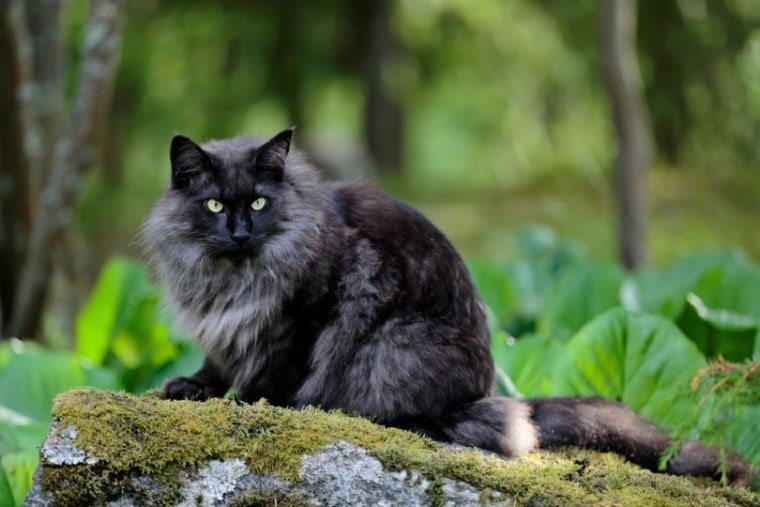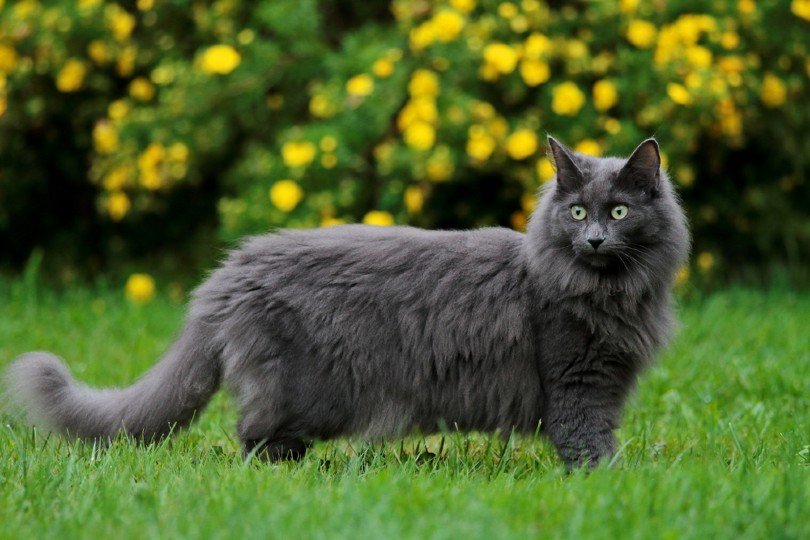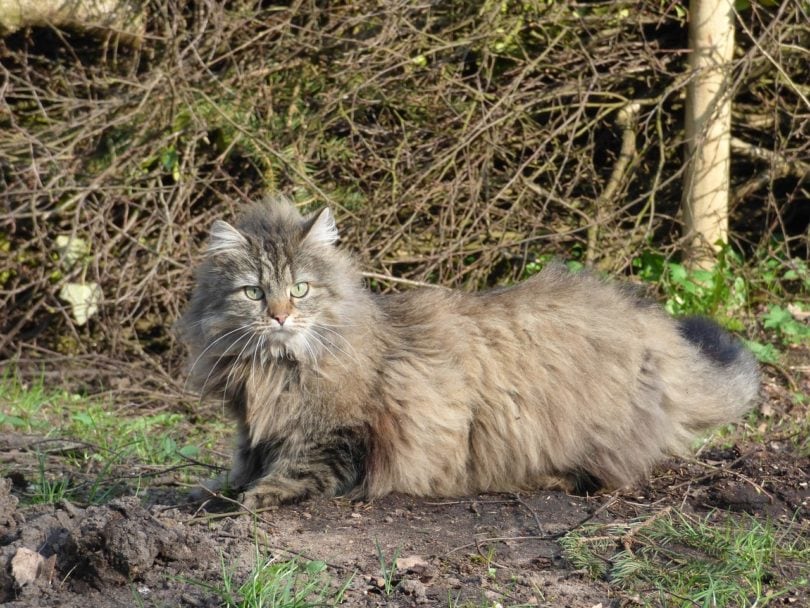
Norwegian Forest Cats, also lovingly called “Wegies,” are large cats with long, muscular bodies and bushy tails. They are an ancient breed that naturally developed in the forests of Norway. Their forest origins are likely the reason that these cats love to climb and hunt today. They are born athletes, preferring to climb as high as they can to observe the world below them.
The first breeding pair of Norwegian Forest Cats in the United States was imported in 1979. Today, they are easy-going cats that love to play and make wonderful family pets. If you own one of these impressive felines, you should know that they are a relatively healthy breed overall. However, they are still prone to certain health issues. By being aware of these potential health problems, you may be able to prevent future complications.
The 6 Common Norwegian Forest Cat Health Problems
1. Hypertrophic Cardiomyopathy
Norwegian Forest Cats are predisposed to hypertrophic cardiomyopathy. This is the most commonly seen form of heart disease in cats. The heart muscle thickens, causing it to become enlarged and impair its function. In severe cases, this condition causes congestive heart failure or even sudden death.
Signs
In many cases, cats show no signs of hypertrophic cardiomyopathy. Some cats may have a heart murmur that is detected by their veterinarian. Signs of congestive heart failure, like a buildup of fluid around the lungs, may be present. Other symptoms include lethargy and difficulty breathing.
Treatment
Treatment for hypertrophic cardiomyopathy depends on the severity of the condition. Mild cases are usually treated with medication. More advanced cases will require additional medications to prevent blood clots. If congestive heart failure is present, some cats may require the fluid around their lungs to be removed.

2. Hip Dysplasia
Hip dysplasia is often seen in dogs, but it can affect cats too. Large cat breeds like the Norwegian Forest Cat are prone to the condition. It’s a genetically and environmentally inherited disease of the hip joint that can cause extreme pain and difficulty walking. Overweight cats and those with poor nutrition can suffer from hip dysplasia. Over time, the malformation of the hip joints will lead to deterioration, and the hips will no longer function properly.
Signs
Signs of hip dysplasia include lameness, difficulty getting up and walking, pain in the hips, reluctance to jump or use stairs, loss of thigh muscle mass, and a decreased range of motion in the hips. Your vet will give your cat an exam and use X-rays to make a diagnosis.
Treatment
Keeping your cat at a healthy weight will help manage its signs and pain. Physical therapy and medications can be used to maintain muscle movement and control pain. Depending on the severity of the condition, surgery may be required to either stabilize the hip joint or completely replace it.
3. Glycogen Storage Disease
Glycogen storage disease is an inherited disease in Norwegian Forest Cats. Affected kittens may die at birth or in the womb. Surviving cats usually show signs of the illness at 5 months old.
The disease is also called glycogenosis, and it occurs when the enzymes that are responsible for metabolizing glycogen in the body are defective. This leads to a buildup of glycogen that can result in organ failure, particularly of the liver, kidneys, and heart.
Signs
This condition is usually so severe that kittens die before or shortly after birth. If affected kittens do survive, common signs include fever, muscle tremors, and weakness.
Treatment
Treatment of glycogen storage disease will depend on the severity of the illness. Unfortunately, this disease will be fatal for most cats, and they will deteriorate rapidly even with treatment. The disease is mostly managed through diet until it no longer works to control the signs.

4. Pyruvate Kinase Deficiency
Pyruvate kinase deficiency is also known as hemolytic Anemia. Norwegian Forest Cats are prone to this genetic disease. The pyruvate kinase enzyme stops the red blood cells from metabolizing normally, which can lead to anemia. It is caused by a genetic defect at birth.
Signs
This disease is identified mostly because the cat will be anemic. The red blood cells are being destroyed, also causing weakness, lethargy, jaundice, and pale mucous membranes. Depending on the severity of the condition, affected cats may experience elevated heart rates and be unable to perform regular physical activities.
Treatment
Unfortunately, the only treatment available for this condition is a bone marrow transplant. This is an expensive procedure and comes with its own risks.
5. Polycystic Kidney Disease
Polycystic kidney disease is most commonly seen in Persian cats, but it is seen in Norwegian Forest Cats, too. This is an inherited disorder that is caused by a gene abnormality. Every cat with this abnormal gene will develop the disease, and it can affect all cats.
This disease causes cysts to form in the kidneys, and they are present in the organs from birth. As they grow larger over time as the cat ages, they will cause the kidneys to malfunction and may cause kidney failure.
Signs
This condition can be difficult to diagnose in the initial stages. The cysts aren’t noticeable until they become large and start to create issues in kidney function. When the disease has progressed, the lumpy kidneys may be detected through an abdominal palpitation by your vet. The cysts themselves are not painful, but the complications that they cause will bring their own sets of symptoms. Kidney failure signs include weakness, lethargy, lack of appetite, vomiting, dehydration, and excessive thirst.
Treatment
Treatment for polycystic kidney disease is catered to treat the severity of each cat’s specific illness. This can include a mix of fluid therapy, specialized diets, and medications to reduce nausea.

6. Diabetes Mellitus
Diabetes mellitus can occur in any cat breed, but Norwegian Forest Cats have a genetic predisposition to the condition.
This is a disease of the pancreas. It stops the pancreas from being able to regulate blood sugar. It is the second most common endocrine disease that is seen in cats of all breeds. Overweight cats are at an increased risk for developing diabetes mellitus. A cat is considered to be obese if they are 3 pounds over their ideal weight.
Signs
There are four main signs of this disease. Weight loss and increased thirst, urination, and appetite are usually the biggest indicators that the condition is present. These signs can be difficult to notice, especially if your cat is not in your presence most of the day. Looking to see how much the water bowl decreases each day will show you how much your cat is drinking. If it’s an excessive amount, it’s a good idea to talk to your vet.
Treatment
Insulin injections are common treatments for this condition. The insulin dosage may need to be adjusted until your vet determines the correct one to work for your cat. It’s a highly treatable disease. With dedication and patience, you can help your cat live a normal life. It’s important to monitor the condition to make sure your cat’s blood sugar is staying at a healthy level.
Other treatments include weight management and a high-protein, low-carbohydrate diet. In some cases, if cats lose enough weight to no longer be considered obese, diabetes mellitus can resolve itself, and no further treatment is necessary.
Keeping Your Norwegian Forest Cat Healthy

These health issues are commonly seen in Norwegian Forest Cats, but your Wegie may never experience any of these conditions. That said, it’s always a good idea to know what to look for when you own a breed that is predisposed to genetic health problems.
The best way to keep your Norwegian Forest Cat healthy is to go to their annual vet visits. Keeping them up to date on vaccines and exams is the simplest way to monitor their health. If any changes are noted in your cat’s health, you can be proactive about treatments.
If you notice any signs in your cat between their annual vet visits, don’t hesitate to take them to the vet. Illnesses can occur at any time, and early detection and treatment are often the best chances that your cat has at overcoming them and making a full recovery.
Conclusion
We hope that you’ve learned more about the common health problems that Norwegian Forest Cats may face in their lives. Healthy Norwegian Forest Cats can live to be 15–20 years old. With proper care and regular vet exams, your cat can stay healthy. Any conditions that may be developing will be detected and treated. Your cat’s best chance at a long, healthy life is regular vet care and your monitoring of their health at home. If you notice any changes in their behavior, contact your vet right away.
Featured Image Credit: Elisa Putti, Shutterstock






